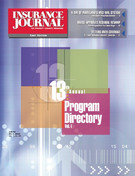Having low risk doctors subsidize premiums for higher risk doctors, establishing state courts exclusively for health matters, abolishing the state’s arbitration office, licensing life care planners, restricting attorney’s fees, and encouraging apologies from health care providers–these are some of the issues addressed by the Maryland task force on medical malpractice.
The Governor’s Task Force on Medical Malpractice and Health Care Access issued its report to Gov. Robert Ehrlich late last month. The 22-member task force, headed by retired Judge Raymond Thieme, included lawyers, doctors, legislators and Ehrlich officials.
The situation
The report provides a history of the market, which has seen malpractice premiums double over past three years. The insurer Medical Mutual began to increase premium levels in 2003, with a 10 percent increase. In 2004 it raised them again by 28 percent. For 2005, the increase will be 33 percent.
Medical Mutual has not been alone in boosting rates. NCROC Group has requested a 25 percent increase for 2005, The Doctor’s Company is seeking a 40 percent jump for next year, and GE Medical Protective received a 59.6 percent increase in August.
Losses on medical malpractice claims appear to be the primary driver of rate increases. The problem has been in the average claim paid, not in the number of claims. In fact, the number of claims has remained constant. There were 722 claims filed in the state in 1996; 667 in 1998; 637 in 2002 and 692 in 2003.
But in just one year the average payment on claims has doubled, according to the report. MedStar Health Inc., which operates four hospitals, saw its average claim payment go from $195,510 in 2002 to $338,248 in 2003. Medical Mutual paid $272,000 on average per claim in 2002 but $386,000 in 2003.
Part of the problem is that the reimbursements doctors receive from managed care companies have not kept up with the higher insurance costs. Managed care executives acknowledge that raising reimbursements might jeopardize their competitive position in the marketplace.
Recommendations
The primary driver of the increase in claims costs is the growth in economic damages contained in settlements, according to the report. A number of the recommendations zero-in on controlling these costs. The report recommends that plaintiffs not receive any amount that would have been paid as income tax if the wages had been earned; that awards reflecting past medical bills be only for the amount actually paid or payable; that there be an objective standard to assess the cost of future medical care; and that any award be reduced by benefits received under any collateral source including Medicaid.
Also, the task force suggests ways to contain non-economic damages. It recommends that the current $650,000 cap on damages for pain and suffering be cut back to $500,000 and the annual $15,000 escalator be eliminated.
Attorneys’ fees in medical malpractice cases range from 33.3 to 40 percent, an amount that is deducted from the settlement even before attorney costs are deducted. In the end, a plaintiff can expect to receive less than 50 cents on the dollar. The task force recommends that Maryland adopt a sliding scale limit on attorneys’ fees similar to California’s.
In addition, it recommends curtailing fee-splitting among attorneys. Lawyers who do not handle malpractice cases may refer clients to specialists who do. When they refer, they often get a fee that can range from 25 to 50 percent of any settlement. The task force recommends limiting this practice.
The report found that the state’s Health Claims Arbitration Office has been ineffective in weeding out cases and has instead become an additional layer of expense and delay. So it recommends abolishing the office. However, it also urges allowing parties to enter into arbitration.
The report also suggests that the state create separate health courts like those in other states that are used to litigate business and family law matters.
Life care planners have become part of the settlement process within the last 10 years. These planners summarize the educational and daily living needs of those who need professional assistance. They serve a legitimate role, according to the task force. But it recommends a study on whether they should be licensed by the state.
Benevolent gestures including apologizing to victims of malpractice, explaining in full what happened, and assuring them that steps are being taken to prevent a reoccurrence can help lessen costs, according to the report. But the current tort system turns any such statements into an admission of guilt. The report urges Maryland to enact legislation that makes an apology or other benevolent gesture by a provider inadmissible in future proceedings.
There is as much as an 800 percent spread among premiums for medical specialties. Bills to compress this rate differential, forcing lower-risk doctors to pay more to subsidize higher-risk doctors, failed in the legislature last session. The Maryland Insurance Administration has warned that allowing rate compression would artificially raise premiums for 75 percent of doctors and provide an opening for unregulated risk retention groups to enter the market and undercut Medical Mutual. The task force listened to MIA’s advice and opposed rate compression.
Doctors have asked for short-term relief– some sort of funding to assist them with the hefty premiums they are facing now. The task force recommends temporary assistance but only if it is done in conjunction with a meaningful set of reforms.
Was this article valuable?
Here are more articles you may enjoy.


 Zurich to Buy AIG’s Travel Insurance Business for $600 Million
Zurich to Buy AIG’s Travel Insurance Business for $600 Million  ‘Extremely Dangerous’ Hurricane Beryl Takes Aim at Caribbean
‘Extremely Dangerous’ Hurricane Beryl Takes Aim at Caribbean  As Rates Rise, Majority of Homeowners Say Insurance Industry Is in Crisis: Survey
As Rates Rise, Majority of Homeowners Say Insurance Industry Is in Crisis: Survey  Farmers Adjusters Cry Foul Over Workloads, Claims Handling in Letter to Regulators
Farmers Adjusters Cry Foul Over Workloads, Claims Handling in Letter to Regulators 


